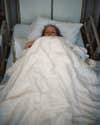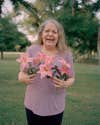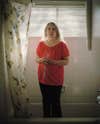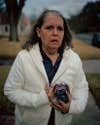A Paranoid Schizophrenic’s Life: A Photographer Son Documents His Mother
“Photography gives me permission to look”

Cesar Lechowick‘s mother, Betty, was diagnosed with paranoid schizophrenia in the mid-’90s when Lechowick was in college, and she has been in and out of state hospitals and group homes ever since. In 2002, Lechowick launched his career as a photographer and began photographing his mother as a way to understand her illness.
“Photography gives me permission to look,” he says. “I think I am less traumatized by what I see and how she is acting if I have the camera. It allows me to interpret events, not just experience them.”

At its core, “Betty’s Sweet Tea” is a photographer’s tribute to his mother. In the majority of images, Betty stares directly into the camera, thus making the photographer’s presence palpable in every photograph. Even on a hospital bed, Betty looks into the camera her lips turned slightly up into a smile and her left eye shut in a wink.
Despite these seemingly intimate gestures that Lechowick has captured, many doctors believe that paranoid schizophrenic patients are incapable of expressing real intimacy. As a result, viewers wonder whether the warmth that is detected in these pictures and the intensity of his mother’s gaze is manufactured by the photographer or a sign of real affection shared between mother and son. This tenuous balance between the real and the fictitious is central to Lechowick’s experience with his mother and her paranoid schizophrenia.
Lechowick says that he often uses color and personal objects to express his vision of his mother’s world. His images beautifully capture the colors of southern Texas where Betty has lived her entire life—the rich yellows, browns and reds create dream-like atmospheres that simultaneously establish a mood and challenge our expectations of a documentary photograph. Lechowick often incorporates symbolic objects or visual metaphors into his images, such as the Styrofoam container of sweet tea or an ornamental mask.
“I want viewers to be stopped in their tracks, to really see my mother in multiple ways,” he explains. “At the Whataburger, for instance, she’s raging; in the fountain and by the creek, she’s seemingly peaceful; and on Christmas Eve, when she stares at me in that white hoodie, she’s beautiful and sad. She is all of these things to me, and I want people to see all these emotions in her. I am trying to create something that refuses to reveal any hard answers.”
Lechowick hopes that his images of his mother contradict many of the tropes of paranoid schizophrenia and other mental illness typically found in photojournalism, such as the woman hiding behind her hair or the man with his tongue dangling out of his mouth.
“I don’t want my photographs to look like typical images of depression and illness,” he explains. “Nevertheless, I am not trying to get rid of how sad and dirty most of her existence is.”
Ultimately, Lechowick creates a complex portrait of paranoid schizophrenia, one that asks questions instead of offering direct answers.










